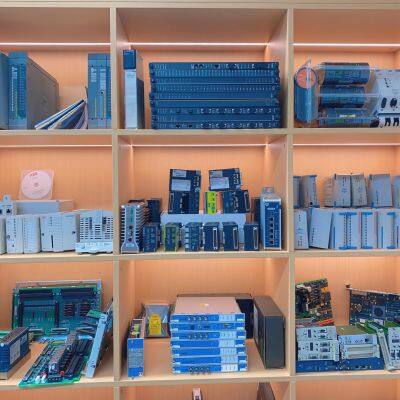Product Description
I. Product Overview
The Allen-Bradley 1771-OBN module is an important DC digital output module in the 1771 series, specially designed for the precise control of DC load devices in industrial automation systems. In industrial production scenarios, the control of the operating status of equipment such as DC solenoid valves, DC relays, and DC indicator lights cannot do without reliable DC output signals. The 1771-OBN module can efficiently receive digital control commands from the PLC controller and convert them into stable DC output signals, thereby driving external DC load devices to work as required, providing strong support for the automated and efficient operation of industrial production processes.
The module adopts a standardized compact structure design, which is highly compatible with the 1771 series I/O enclosures and can be easily installed in various models of industrial control cabinets, greatly saving installation space. Its shell is made of high-quality industrial-grade plastic material, which has passed strict environmental tests, and has excellent anti-vibration and anti-impact performance. It can maintain stable operation in environments with continuous vibration such as mechanical processing workshops and automated production lines. At the same time, the shell also has a certain degree of dust-proof and moisture-proof capabilities, which can adapt to the complex working conditions of dust and humidity in industrial sites, ensuring that the module can perform output control tasks reliably for a long time.

II. Performance Parameters
(1) Electrical Characteristics
Power Requirement: The working power of the 1771-OBN module comes from the backplane of the 1771 I/O enclosure, usually requiring +5V DC power supply, with a typical current consumption within a specific range. This power supply method can share power with other modules in the enclosure, eliminating the need for an additional independent power supply, simplifying the system's power supply design, reducing overall costs, and ensuring the stability of power supply.
Number of Output Points: The module has 16 DC digital output channels, which can control 16 DC load devices at the same time, meeting the needs of small and medium-sized industrial control systems for multi-device DC control. If more devices need to be controlled, flexible expansion can be achieved by increasing the number of modules.
Output Signal Type: It supports DC output signals, with an output voltage range generally from 10V DC to 30V DC. It is compatible with a variety of DC load devices, has strong versatility, and can be adapted to DC loads with different rated voltages.
Output Current: The rated current of each output channel is usually 0.5A (resistive load), and it can work stably when dealing with inductive loads. When multiple channels work at the same time, the total current must be controlled within the specified range to avoid overload and ensure the safe operation of the module.
Switching Frequency: The switching frequency of the output channel is at a medium level, which can meet the frequency requirements for equipment start-stop control in most industrial production scenarios, ensuring timely response and accurate action of the equipment.
(2) Interface Characteristics
External Load Interface: Equipped with a standard terminal block for connecting external DC load devices. The terminal block adopts a screw fixing method, which makes the wiring firm and reliable, and can effectively prevent loose wiring caused by vibration, collision and other factors, ensuring the stability of signal transmission and load driving. The interface marks are clear, clearly distinguishing the terminals of each output channel and the common terminal, which is convenient for technicians to complete the wiring operation quickly and accurately.
Backplane Communication Interface: It communicates with the PLC processor through the backplane connector of the 1771 I/O enclosure, receives control commands sent by the PLC controller, and converts them into corresponding DC output signals. The backplane interface adopts a reliable electrical connection design to ensure the timeliness and accuracy of control command transmission, enabling the module to quickly respond to the control requirements of the PLC.
(3) Environmental Adaptability
Operating Temperature: It can work stably in the temperature range of 0°C to 60°C, and can adapt to common temperature changes in industrial production workshops. Whether it is a high-temperature workshop environment in summer or a low-temperature area in winter, it will not affect its output control performance and working stability.
Storage Temperature: In the storage state, it can withstand extreme temperatures from -40°C to 85°C, ensuring that the internal components of the module will not be damaged even in harsh temperature conditions during transportation and long-term storage, and ensuring the performance reliability of the module.
Anti-Electromagnetic Interference: It meets industrial-grade electromagnetic compatibility standards and has a certain anti-electromagnetic interference capability. It can resist electromagnetic interference generated by equipment such as motors, transformers, and electric welders in industrial sites, prevent output signals from malfunctioning due to interference, and ensure the accuracy of control over external equipment.
III. Functional Characteristics
(1) Reliable DC Output Control
The core function of the 1771-OBN module is to convert the digital control commands (0 and 1) from the PLC controller into corresponding DC output signals, so as to realize reliable control of external DC load devices. When receiving the "1" command from the PLC, the corresponding output channel is turned on, and the DC voltage is output to drive the load device to work; when receiving the "0" command, the output channel is turned off, and the load device stops working. Whether it is long-term stable output control or frequent switching operations, the module can perform stably and reliably, providing a solid guarantee for the automated control of industrial production. For example, in an automated assembly line, the module can control the action of DC solenoid valves to realize the precise grabbing and placing of components, ensuring the orderly progress of the assembly process.
(2) Status Indication Function
The module is equipped with intuitive status indicators, including a power indicator and status indicators for each output point. The power indicator being on indicates that the module is powered normally; each output point corresponds to a status indicator, and when the output point is in the on state, the corresponding indicator will light up, clearly reflecting the working status of each output point. This brings great convenience to technicians for debugging and troubleshooting. By observing the status of the indicators, they can quickly judge whether the module is working normally, whether the output channel is on, and whether the external load responds normally.
(3) Overload Protection Capability
The 1771-OBN module has a certain overload protection function. When the load connected to the output channel is overloaded, the module can automatically detect the abnormality and quickly cut off the output of the channel, preventing internal components of the module from being damaged due to overcurrent, and avoiding the fault from affecting the normal operation of other channels. After the fault is eliminated, the module can resume normal operation, which improves the reliability and service life of the module and reduces the risk of system failure caused by abnormal loads.
(4) Good Compatibility and Expandability
This module has excellent compatibility with Allen-Bradley PLC-5 series controllers, and can be directly connected to the PLC system without complex configuration and debugging processes. At the same time, it supports mixed installation with other types of modules (such as digital input modules, analog modules, etc.) in the 1771 I/O enclosure, which is convenient for users to build a complete industrial automation control system according to actual needs. When the production scale expands or the number of controlled devices increases, users can expand the number of output points by increasing the number of 1771-OBN modules, improving the flexibility and expandability of the system.

IV. Installation Steps
Preparation before Installation: Before installation, check whether the appearance of the module is intact, whether there is damage, deformation, etc., and confirm that the terminal block and other components are not loose. At the same time, ensure that the installation environment meets the working requirements of the module, away from strong electromagnetic interference sources, high-temperature heat sources and corrosive substances. Prepare necessary installation tools, such as screwdrivers, wire strippers, etc., and disconnect the power supply of the 1771 I/O enclosure to ensure the safety of the installation process.
Module Installation: Align the 1771-OBN module with the empty slot of the 1771 I/O enclosure, push it in smoothly along the guide rail until the module is in close contact with the enclosure backplane connector, and then fix the module on the enclosure with screws to prevent the module from loosening due to vibration during equipment operation, which will affect the stability of electrical connection.
External Wiring: According to the system electrical schematic diagram, connect the connecting wires of external DC load devices to the terminal block of the module. When wiring, pay attention to distinguishing the terminals of each output channel and the common terminal, connect them correctly according to the terminal marks, ensure that the wiring is firm and reliable, and avoid virtual connection. At the same time, pay attention to the correct connection of the positive and negative poles of the DC power supply to prevent damage to the equipment caused by wrong connection.
Installation Inspection: After the installation is completed, carefully check the fixing of the module and whether the external wiring is correct. After confirmation, power on the 1771 I/O enclosure and observe whether the power indicator of the module is on. If it is on, it indicates that the module is powered normally.


Allen-Bradley 1771-P4S Power Supply Module
Allen-Bradley 1771-VHSC Very High-Speed Counter Module
GE IS200TDBSH2ACC Terminal Base Module
GE IS230TNDSH2A Terminal Base Module
GE SR745-W2-P1-G1-HI-A-L-R-E Transformer Protection System
Schneider TM251MESE Logic Controller
Schneider TM3AQ4 Output Module
Schneider TM3AI8 Analog Input Expansion Module
DEIF DLQ144-PC-NB Multi-Function Controller
VANGUARD PSMU-350-3 CPCI-350Q-P-38 Power Supply
Prosoft 202-DFNT-MCM4 Communications Module
Prosoft 5202-DFNT-MCM4 Communications Module
 yezi
Hi there! Welcome to my shop. Let me know if you have any questions.
yezi
Hi there! Welcome to my shop. Let me know if you have any questions.




